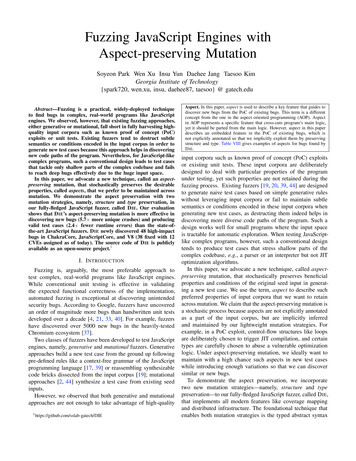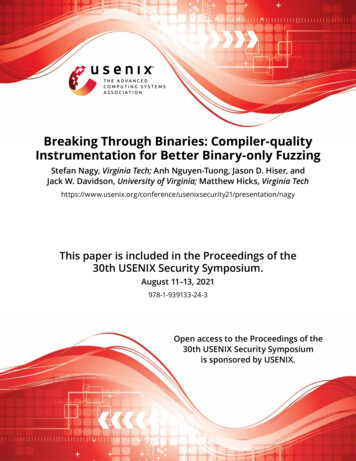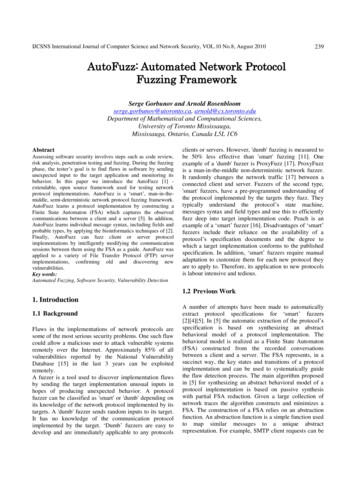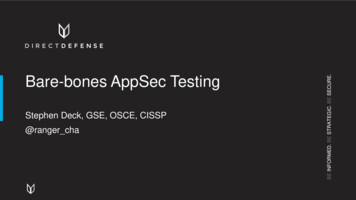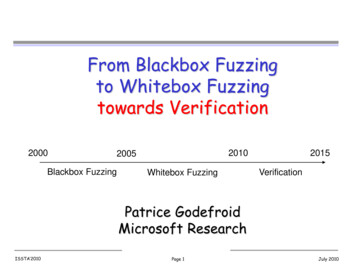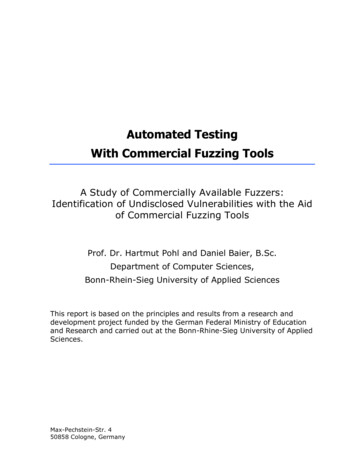
Transcription
Automated TestingWith Commercial Fuzzing ToolsA Study of Commercially Available Fuzzers:Identification of Undisclosed Vulnerabilities with the Aidof Commercial Fuzzing ToolsProf. Dr. Hartmut Pohl and Daniel Baier, B.Sc.Department of Computer Sciences,Bonn-Rhein-Sieg University of Applied SciencesThis report is based on the principles and results from a research anddevelopment project funded by the German Federal Ministry of Educationand Research and carried out at the Bonn-Rhine-Sieg University of AppliedSciences.Max-Pechstein-Str. 450858 Cologne, Germany
1.SummaryBugs relevant to security in applications (vulnerabilities) are among the most frequent andthus riskiest attack targets in company IT systems. Cost-effective, tool-based Fuzzingtechniques help to identify hitherto unknown security relevant bugs. The aim of this reportis to analyze, assess and compare Fuzzing tools.In a series of projects, hitherto unknown vulnerabilities in individual and standardsoftware were identified and also fixed by the respective software developer using Fuzzingtechniques. This report is aimed at comparing the efficiency of commercially availableFuzzers.The good results achieved to date show that Fuzzing techniques identify criticalvulnerabilities which are exploitable from the Internet - despite a high security standard inthe programming guidelines [Pohl 2010a]. Commercial Fuzzers - beSTORM in particular enable the quick and targeted examination of an application with respect to its securitylevel because they can be operated intuitively and provide comprehensive interfacesupport.The efficiency of the individual techniques and tools was examined in practice - the Top25 vulnerabilities can (only) be identified using a combination of Threat Modeling,Fuzzing and examining the source code [Pohl 2010b, 2010c; MITRE 2010].2.Motivating Factors/MotivationIt is impossible to develop bug-free software. This makes the testing of softwarenecessary, while maintaining a close link to quality assurance. It is impractical to conductmanual tests of software that has large quantities of programming codes [Sutton 2007].Therefore, tool-based, automated techniques are required to identify vulnerabilities.This is because security vulnerabilities in applications are among the most frequentlydiscovered and thus riskiest attack targets in company IT systems. Vulnerabilities inapplications enable, among other things, attacks from the Internet and thus data loss,(industrial) espionage, and sabotage. In many cases, these attacks also make itpossible to successfully attack the underlying, internally linked company IT systems andthus to access company-internal IT networking systems and critical IT infrastructures,such as financial data, Enterprise Resource Planning Systems (ERP), CustomerRelationship Management Systems (CRM), production control systems, etc.Traditional security tools only enable the identification of known attacks that exploitknown vulnerabilities; such security tools include, for instance, (web application) firewalls,intrusion detection systems, etc. Hence, they cannot be used to detect new attacks andnew types of attacks.Beyond this, state-of-the-art security tools support the identification of hitherto unknownvulnerabilities and the detection of new types of attacks based on these vulnerabilities.Threat Modeling makes it possible to identify vulnerabilities early in the design phase.Static source code analysis (Static Analysis) is aimed at analyzing the source codewithout executing it. This tests whether the code conforms to the programminglanguage and the programming guidelines during the implementation phase. StaticAnalysis tools work like parsers that conduct lexical, syntactic and semantic analysesof programming codes.Dynamic analysis tools (Fuzzers) transmit random input data to the target programto trigger anomalous program behavior. Such anomalies indicate vulnerabilities.Hartmut Pohl: Automated Testing with Commercial Fuzzing Tools2
Microsoft has been using the advantages of Threat Modeling [Howard 2006] and Fuzzing[Godefroid 2008] since 2003 as an integral part of its own "secure" software developmentprocess - the Security Development Lifecycle (SDL) [Howard 2006].The cost of fixing vulnerabilities rises exponentially in the course of the softwaredevelopment process [NIST 2002]. If bugs are identified in the testing or verificationphase, the cost rises by the factor 15 compared to their being detected during the designphase. If the bugs are identified during the release phase (or even later), the cost rises bythe factor 100 (cf. Figure 1).Figure 1: Cost of Bug Elimination in the Software Development Lifecycle [NIST 2002]3.Fuzzing3.1.Introduction to FuzzingFuzz-testing (Fuzzing) is a software testing technique that is ideally used during theverification phase within the Security Development Lifecycle (SDL) [Lipner 2005], yet it isequally successful at a later stage, when the software has been delivered to thecustomer. The verification phase is located between the implementation and the releasephase within the SDL (Figure 1).The Fuzzing process [cf. Figure 2] describes how Fuzzing tests are conducted:1. Identifying input interfaces,2. generating input data,3. transmitting input data,4. monitoring the target software,5. conducting an exception analysis and6. drawing up reports/reporting.Hartmut Pohl: Automated Testing with Commercial Fuzzing Tools3
After the interfaces have been successfully identified, input data can be generated usinga Fuzzer; these data can then be transmitted to the target software to be tested. Duringthe Fuzzing process the software is monitored so as to detect anomalous programbehavior, which are triggered by randomly and intelligently selecting the widest possiblerange of input data.Figure 2: Fuzzing ProcessAt last the results are reported to management and the technicians; the latter compile allinformation found during the execution of the program.Fuzzing is a tool-based technique used to identify software bugs during the verificationphase; this can contribute to identifying undisclosed security relevant bugs. To this end,the input interfaces of the target software to be tested are identified, to which targeteddata are directed in an automated fashion while the software is being monitored forpotential bugs. This makes it possible to prevent third parties from identifyingvulnerabilities and thus from developing zero-day-exploits [Pohl 2007].Zero-day exploits are one of the twenty most frequent types of attacks [SANS 2010].Fuzzing can be conducted both in the form of a white-box test (with available sourcecode) and, above all, in the form of a black-box test (with no available source code)during the verification phase.3.2.Market AnalysisThere are more than 250 Fuzzers. 25% of all Fuzzers can be used to test webapplications and 45% can be used to examine network protocols. The testing of fileformats is supported by 15% of all Fuzzers. Web browsers can be examined by 10% ofall Fuzzers, whereas APIs can be tested by 7% of all Fuzzing tools. There are only twomulti-protocol, environment variable fuzzers. [Cf. Figure 3: Market Overview of Fuzzers]Hartmut Pohl: Automated Testing with Commercial Fuzzing Tools4
Figure 3: Market Overview of Fuzzers3.3.Case Study: Testing FuzzersIn a fuzzer case study done for Bonn-Rhine-Sieg University of Applied Sciences, a largenumber of vulnerabilities were identified using the commercial Fuzzers evaluated below.In this real world evaluation, published software, i.e. software applications purchasableon the market, was tested to failure. The levels of severity assigned to the vulnerabilitieswere calculated using the Common Vulnerability Scoring System [Mell 2007] and thengraphically represented as "Critical", "High", "Medium", "Low", "Undefined" - accordingto their degrees of criticality. The more severe the vulnerability, the higher thepotential harm and the lower the effort required to exploit the vulnerability. Thevulnerabilities detailed in figure 4 were discovered during the testing process.Figure 4: Vulnerabilities Identified with the Aid of Fuzzing, during the Case StudyHartmut Pohl: Automated Testing with Commercial Fuzzing Tools5
3.4.Fuzzer Evaluation ParametersVarious parameters have been drawn up to evaluate testing tools. The following eightevaluation parameters are important with respect to Fuzzing:Supported Fuzzing techniques and protocols: The aim of this parameter is toevaluate the possibility of using a Fuzzer to perform diverse tasks, including, forinstance, the tool's ability to independently interpret interfaces, to adapt to protocolspecifications and the scope for using it to interpret the target software.Costs and license: evaluation of the costs arising from each tool, includingpurchasing, maintenance and personnel costs as quantified on the basis of actual use.Analytical abilities: evaluation of the extent to which the Fuzzer is able to conductanalyses. This includes the monitoring techniques supported, the identification ofvulnerabilities, the way the target software is reset and reporting. Furthermore, suchcriteria as the ability to establish parameters, bug reproduction, support for parallelFuzzing as well as interruption and resumption of Fuzz tests are taken into account.Operating systems: this examines the question of which operating systems theFuzzer can be used on and, above all, the question of whether the software isindependent of the platform used.Software ergonomics: evaluation of the respective tool's efficiency, profitability anduser-friendliness during the conduction of Fuzzing tests. Moreover, functional, dialogas well as input and output criteria are assessed.Documentation: evaluation of the completeness and quality of the documentationresources provided, such as user manuals, technical and third party documentation,as well as evaluation of the quality of the user interface.Extendibility: evaluation of the ability of the tool to supplement or extendexisting features. The interfaces included, the programming language and thedeveloping tools required are also taken into account.Further parameters: evaluation of further methods and features provided byFuzzers to improve the quality of Fuzzing. Above all, the scope for identifying,defining, evaluating and presenting bugs is evaluated.These parameters enable the consistent classification and evaluation of Fuzzers and serveas a basis of ranking them on their merits.3.5.Fuzzer AnalysisIn the following review, six different examples of commercial, widely used Fuzzers wereexamined. The Fuzzers examined and evaluated can be seen from Figure 5 -CommercialFuzzers Examined.Fuzzing tools from the category of "Multi-Protocol Fuzzers" support most protocols andcan thus be used to examine several interfaces. Fuzzers from the category of "WebApplication Fuzzers" count among the remote Fuzzers, even though their application isnot restricted to web applications.Hartmut Pohl: Automated Testing with Commercial Fuzzing Tools6
NameCategoryOperating SystemVersionbeSTORMMulti-ProtocolFuzzerMicrosoft Windows,Linux (i386)3.7.5 (4480)Multi-ProtocolFuzzerIndependent ofOperating System3.8.3Web ApplicationFuzzerMicrosoft Windows8.0.1087.701Web ApplicationFuzzerUnix, MicrosoftWindows1.3.09Web ApplicationFuzzerMicrosoft Windows2009 build 7Web ApplicationFuzzerMicrosoft Windows8.0Tool ADefensicsTool BAppscan Standard EditionTool CBurp Suite ProTool DN-Stalker Pro EditionTool EHP WebinspectTool FFigure 5: Commercial Fuzzers ExaminedOn the whole, Tool A stands out. It shows high standards of user-friendly handling andoperation, of the Fuzzing techniques supported and the analytical abilities provided.Both Tool A as well as Tool B enables the user to reset the target application after systemfailure and implements the reproduction of bugs identified. Tool A generates a Perl scriptthat reproduces the bug (the vulnerability).Tool B, which shows markedly higher purchasing costs, supports a larger number ofFuzzing techniques. However, the utilization of the individual features is made difficultby user interface complexity.Tools C and F attain very good results for user friendliness. On the other hand, they bothachieve low scores for their application possibilities and the Fuzzing techniques theysupport. The difference between them is very slight, with Tool F being slightly better thanTool C.Tool D attains a satisfactory result for user friendliness. On the other hand, it excels interms of its low purchasing costs. The tool only supports a small number of Fuzzingtechniques, yet its analytical abilities are comprehensive.Tool E excels in terms of very high scores for user friendliness. However, it onlysupports a small number of Fuzzing techniques, which are evaluated on the basis of thegood analytical abilities it provides. Documentation is also assigned a low score.The costs of the tools differ considerably. Tool B shows the highest purchasing costs.Tools A, C and F are in the same price segment, differing from each other only slightly.Tools D and E excel in terms of their low purchasing costs, with Tool D beingconsiderably cheaper. Owing to their complexity and low user friendliness, Tools Band D are characterized by higher personnel costs.Each of the evaluation parameters is assigned between 0 and a maximum of 10 points,with 10 points being the maximum, i.e. best (evaluation) result achievable. These resultsare graphically represented in Figure 6: Evaluation of the Fuzzers.Hartmut Pohl: Automated Testing with Commercial Fuzzing Tools7
Figure 6: Evaluation of the FuzzersIf Fuzzers are to be used for several interfaces, the degree to which interfaces aresupported should be taken into account. The expertise required to use Fuzzers is anothercriterion on which the evaluation of Fuzzers may be CompatibleProtocolsA BC D E F Analysis Depth Further CompanySpecificParametersExtendibilityFigure 7: Comparison of Fuzzers on the Basis of the Interfaces and Expertise RequiredHartmut Pohl: Automated Testing with Commercial Fuzzing Tools8
Tools A and B support a larger number of interfaces than Tools C, D, E and F. However,Tool B requires a higher level of expertise. Cf. Figure 8: Comparison of Fuzzers on theBasis of the Interfaces and Expertise Required.Figure 8: Evaluation Results:Comparison of Fuzzers on the Basis of the Interfaces and Expertise Required4.Commercial Fuzzer Comparison ResultsAfter comparing commercially available Fuzzers, beSTORM was selected as the overallbest in class as it achieved above average results in all parameters. Apart from beingparticularly user-friendly in terms of handling, beSTORM excels in terms of the Fuzzingtechniques supported and the analytical abilities provided; it supports 54 protocolsand file formats.beSTORM is a "Smart-Stateful-Grammar-Based-Generation-Based Fuzzer". It alsocontains a component to adapt to protocol specifications; hence, it can just as well beclassified as a Based Fuzzer".Furthermore, it can also be regarded as a "Protocol-Specific - Multi-Protocol Fuzzer"because it supports multiple protocols.beSTORM is provided with the functionality to detect the occurrence of service denials for instance, on the basis of such criteria as CPU activity, storage utilization and targetprogram failure. The tool is also capable of identifying memory access violations.beSTORM is highly efficient and cost-effective in terms of application; the dialogs meetexpectations and are self-explanatory throughout. The basic usability criteria are compliedwith; even though the tool is particularly user-friendly in terms of handling, there is stillenough potential for the future development of further versions.The beSTORM user manual is available in English. It also contains a description of theprotocol specification format and can thus be seen as technical documentation. A supportsystem is also integral to the manual.Hartmut Pohl: Automated Testing with Commercial Fuzzing Tools9
Along with the software, the purchaser receives a tutorial in the form of a quick startguide. The developer's site provides the opportunity to gain insights into a large numberof white papers and case studies. Webinars are also conducted.In summary, beSTORM shows higher standards in a number of areas than itscommercial competitors: above all, beSTORM excels in terms of the good softwareergonomics it provides. The dialogs are user-friendly and self-explanatory; there iscomplete and detailed documentation available. The tool supports comprehensiveFuzzing techniques and has considerable analytical abilities.5.References[Beyond 2010]Beyond Security (Ed ): Beyond Security - Vulnerability Assessment and Management.McLean 2010. http://www.beyondsecurity.com[Codenomicon 2010]Codenomicon (Ed.): Codenomicon 1 DEFENSICS. Defend. Then Deploy. Oulu 2010.http://www.codenomicon.cornGodefroid, P.; Kiezun, A.; Levin, N.Y.: Grammar-based Whitebox Fuzzing. 0.0. 2008.http://research.microsoft.com/en -1.1s/projects/atg/pldi2800.pdfHoward, M.; Lipner, Steve: The Security Development Lifecycle. SDL: A Process forDeveloping Demonstrably More Secure Software. Microsoft press, Redmond 2006.HP (Ed.): HP WebInspect software. Houston ain/hpms content.jsp?zn bto&cp 1-11-201-200 95704000 100IBM (Ed.): Rational AppScan Standard Edition. New York ani/standard/Lipner, S.; Howard, M.: The Trustworthy Computing Security Development Lifecycle.0.0. 2005. Meland, .H.: SeaMonster: Providing tool support for security modeling. Agder er nisk2008.pdf[Godefroid 2008][Howard 2006][HP 2010][IBM 2010][Lipner 2005][Meland, 2008][Melt 2007][Microsoft 2009][MITRE 2010]:[NIST 2002][N-Stalker 2010][Pohl 2007][Pohl 2010a][Pohl 2010b][Pohl 2010c][PortSwigger 2010][SANS 10][Schneier 1999][Sutton 2007][Swiderski 2004]Hell, P; Scarfone, K; Romanosky, S: A Complete Guide to the Common VulnerabilityScoring System Version 2.0. 0.0. 2007. http://www.first.org/cvss/cvss-guide.pdfMicrosoft (Ed.): Threat Analysis And Modeling (TAM) v3.0 - Learn about the NewFeatures! Redmond earn-about-the-new-features.aspxMITRE (Ed.): 2010 CWE/SANS Top 25: Focus Profiles - Automated vs. Manual Analysis.Eagle River 2010. signImpNational Institute of Standards and Technology (NIST) (Ed.):: The Economic Impacts ofInadequate Infrastructure for Software Testing. Gaithersburg 2-3.pdfN-Stalker (Ed.): N-Stalker The Web Security Specialists. Sao Paulo 2011.http://nstalker.com/proclucts/enterprisePohl, H.: Zur Technik der heimlichen Online Durchsuchung. Du D, Ausg. 31. 2007, 684 688.Pohl, H.: Rapid Security Framework (RSF). 18. DFN Workshop Sicherheit in vernetztenSysternen. Hamburg 2010Pohl, H.: Entwicklungshelfer and Str-esstester - Tool-gestiii2te Identifizierung vonSicherheitskicken in verschiedenen Stadien des Softwarelebenszyklus. In: kes - DieFachzeitschrift filir Informations-Sicherheit, 2, 2010Pohl,H.: Rapid Security Framework (RSF). Zus. mit Liibbert, 3.: 18. DFN WorkshopSicherheit in vernelaten Systemen. Hamburg 2010PortSwigger (Ed.): PortSwigger Web Security - Burp Suite is the leading toolkit for webapplication testing. London 2011. http://www.portswigger.net/SANS (Ed.): The Top Cyber Security Risks. 0.0. 2010 httpliwww.sans.org/top-cybersecurity-risks/?ref top20Schneier, B.: Attack Trees. 0.0. 1999. rn1Sutton, M.; Greene, A.; Amini, P.: Fuzzing - Brute Force Vulnerability Discovery. NewYork 2007.Swiderski, F.; Snyder, W.: Threat Modeling. Redmond 2004.Hartmut Pohl: Automated Testing with Commercial Fuzzing Tools10
language and the programming guidelines during the implementation phase. Static Analysis tools work like parsers that conduct lexical, syntactic and semantic analyses of programming codes. Dynamic analysis tools (Fuzzers) transmit random input data to the target program to trigger anomalous program behavior. Such anomalies indicate vulnerabilities.
